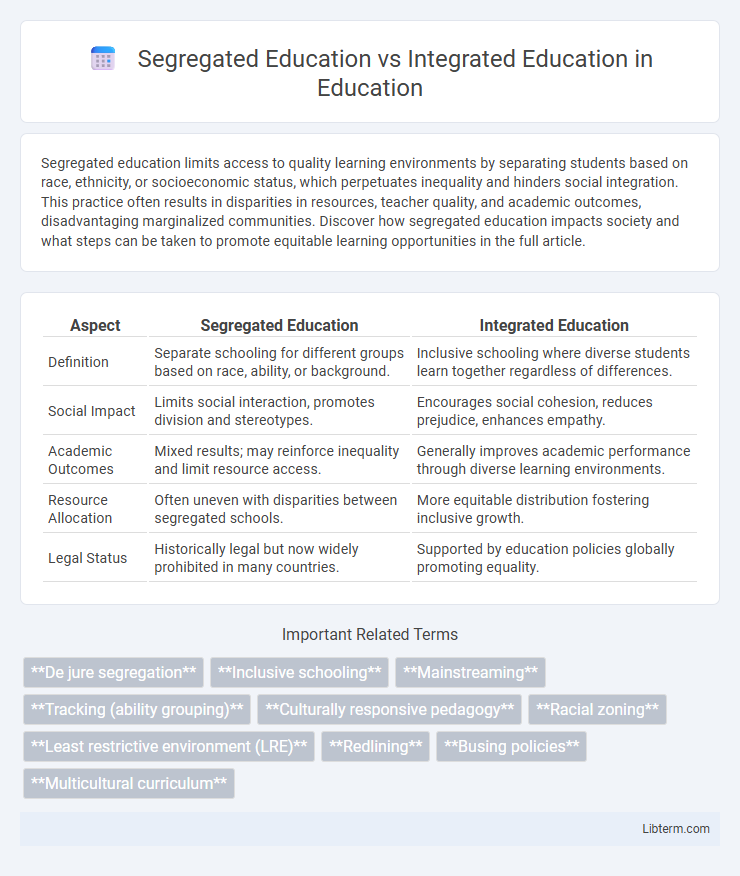Segregated education limits access to quality learning environments by separating students based on race, ethnicity, or socioeconomic status, which perpetuates inequality and hinders social integration. This practice often results in disparities in resources, teacher quality, and academic outcomes, disadvantaging marginalized communities. Discover how segregated education impacts society and what steps can be taken to promote equitable learning opportunities in the full article.
Table of Comparison
| Aspect | Segregated Education | Integrated Education |
|---|---|---|
| Definition | Separate schooling for different groups based on race, ability, or background. | Inclusive schooling where diverse students learn together regardless of differences. |
| Social Impact | Limits social interaction, promotes division and stereotypes. | Encourages social cohesion, reduces prejudice, enhances empathy. |
| Academic Outcomes | Mixed results; may reinforce inequality and limit resource access. | Generally improves academic performance through diverse learning environments. |
| Resource Allocation | Often uneven with disparities between segregated schools. | More equitable distribution fostering inclusive growth. |
| Legal Status | Historically legal but now widely prohibited in many countries. | Supported by education policies globally promoting equality. |
Understanding Segregated Education
Segregated education refers to the systematic separation of students based on race, ethnicity, disability, or socioeconomic status, often resulting in unequal access to educational resources and opportunities. Historical examples include racially segregated schools under Jim Crow laws in the United States, which perpetuated disparities in academic achievement and social integration. Understanding segregated education highlights the long-term impact on marginalized communities and the ongoing challenges in achieving equitable education systems worldwide.
Defining Integrated Education
Integrated education refers to an inclusive approach where students of diverse abilities, backgrounds, and needs learn together in the same classroom environment. This model promotes social interaction, equal opportunities, and collaboration among all students, fostering empathy and reducing discrimination. Research indicates integrated education enhances academic performance and social skills by providing tailored support within a unified setting.
Historical Context and Evolution
Segregated education, rooted in legal and social policies like the Jim Crow laws in the United States, enforced racial separation in schools, profoundly shaping educational disparities. The landmark 1954 Supreme Court decision in Brown v. Board of Education catalyzed the push toward integrated education by declaring segregation unconstitutional, marking a pivotal evolution in educational equity. Over time, integrated education has aimed to promote inclusivity and equal access, although contemporary debates continue regarding its effectiveness and implementation challenges.
Key Differences Between Segregated and Integrated Education
Segregated education separates students based on race, disability, or socio-economic status, often leading to unequal resource allocation and limited social interaction across diverse groups. Integrated education promotes inclusive classrooms where students of different backgrounds learn together, fostering equity, diversity, and mutual understanding. Key differences include the impact on social cohesion, access to quality education, and the development of empathy and collaboration skills among students.
Social Impacts on Students
Segregated education often reinforces social divisions by limiting diverse interactions and perpetuating stereotypes among students, which can hinder social cohesion and empathy development. Integrated education promotes inclusivity and cross-cultural understanding, allowing students to build meaningful relationships across different backgrounds and reduce prejudice. Research indicates that students in integrated settings demonstrate higher social competence, improved conflict resolution skills, and greater acceptance of diversity.
Academic Outcomes and Achievement Gaps
Integrated education consistently demonstrates improved academic outcomes by fostering diverse learning environments that enhance critical thinking and social skills. Studies reveal that achievement gaps between marginalized and privileged groups narrow significantly in integrated settings due to equitable resource distribution and inclusive pedagogical approaches. Segregated education often perpetuates disparities, limiting access to quality instruction and reinforcing systemic inequalities that adversely affect student performance.
Legal Frameworks and Policies
Legal frameworks governing segregated and integrated education vary significantly across countries, with integrated education often supported by anti-discrimination laws such as the U.S. Individuals with Disabilities Education Act (IDEA) and the European Union's directives on inclusive education. Policies promoting integrated education emphasize equal access, non-discrimination, and individualized accommodations to ensure students with disabilities participate fully in mainstream classrooms. Conversely, segregated education is frequently regulated by special education statutes that allow for separate facilities when inclusion is deemed impractical or when specific educational needs cannot be met in integrated settings.
Challenges in Implementation
Segregated education faces challenges such as reinforcing social inequalities and limited resource allocation, which hinder equal access to quality learning. Integrated education struggles with logistical issues like curriculum adaptation and teacher training to accommodate diverse student needs effectively. Both models encounter resistance from stakeholders due to cultural biases and concerns about academic standards.
Benefits of Inclusive Learning Environments
Inclusive learning environments promote cognitive development and social skills by encouraging interaction among diverse student groups. Research shows that students in integrated classrooms exhibit higher empathy and collaboration abilities compared to those in segregated education. Access to varied perspectives in inclusive settings also prepares learners for real-world challenges, enhancing academic outcomes and lifelong success.
Future Directions in Educational Models
Future directions in educational models emphasize the shift toward integrated education, promoting inclusivity and diverse learning environments that enhance social cohesion and academic performance. Research indicates integrated classrooms improve critical thinking, empathy, and cultural awareness, addressing systemic inequalities present in segregated education systems. Emerging technologies and personalized learning strategies further support integration by accommodating diverse student needs, fostering equitable access to quality education for all.
Segregated Education Infographic

 libterm.com
libterm.com